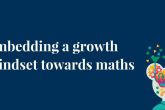
Josh Lury, Power Maths author, explores how storytelling plays a vital role in teaching maths.
One of my favourite times of the school day is reading the class story before home time – the children sit in rapt attention, rising and falling with the fortunes of their favourite characters. I’ve always been interested in the thinking skills that underpin all learning. The powerful magic of storytelling can play a deep role in maths teaching, too.
Think back to what it felt like to be told a story as a child, to the magic of a world growing in your imagination, built out of words and smells and characters. Those characters did not have to be wild or wacky to be interesting, but if they were, what mattered more was that their hopes and fears, their faults and their power to overcome, brought them to life. Stories are not just for children, nor are they just for entertainment. They’re at the heart of how we understand the inner world of our thoughts and feelings and the outer world of cause and effect.
Structuring a story in maths
The structure of any story is more or less universal: someone has a goal but the path to that goal is blocked. The story is the journey made in overcoming the obstacles, whether a literal journey across the sea, or a metaphorical journey through a social and emotional landscape. We can harness this same structure to design compelling maths lessons. Most of the ingredients are there already: a problem to be solved with obstacles along the way, and most importantly a change in the main character – new knowledge and skills for children. What sets apart a truly satisfying story is the change that goes on inside the main character, what they learn about themselves and what internal barriers they overcome. And you might easily say the same about a truly effective maths lesson.
Stage 1: the hook
The first stage is the hook. It doesn’t need to be a big song and dance, just something that fires the imagination or harnesses the emotions. There could be a picture of a girl emptying her piggy bank, a farmer fencing off a field, a caterpillar eating through some fruit. Perhaps the girl is looking mournfully at a bicycle with a price tag of £55, the farmer looking quizzically at two stacks of ten fence panels, and the caterpillar seems very hungry indeed. Or it could be a more mathematical context: a pattern on a 100 square, or a quadrilateral on a geoboard. The hook works if there is something to discover, a mystery or a narrative to complete. The teacher must know the quest upon which the class will embark, and must help the class prepare to set off in a particular direction. The goal must be very clear so that the learning is coherent and appropriate, and the class will know if they have succeeded on their quest.
Stage 2: the journey
The second stage is the journey. Using a mastery approach the children work on one small step together, going deep into the one specific concept through discussion, meaningful practice and probing questions. Overcoming the problem requires deeper understanding and a new way of looking at things, which turns into new knowledge and new skills built on secure foundations. The teacher is the guide, a little like Dungeon Master, perhaps, making sure the class do not travel too far too early or veer too far off course, but never just giving the game away. There’s great skill in prompting and refining, and strong visual representations and use of manipulatives can help the class
Stage 3: the solution
The third stage is the solution. The class set out on a definite quest with a very specific goal. In this stage, the class uses their new knowledge to describe and explain the answer and the teacher helps draw together the concrete, pictorial and the abstract. How do the different parts of the abstract calculation, and the representations, relate to the concrete problem?
The end
The next stage is the deepest. The specific story has finished, but now it becomes a more general truth. Macbeth is not only relevant to murderous Scottish kings, but to anyone who has ever felt envy, desire, guilt and grief. So too, the best maths lessons prompt generalisable new skills. It’s not especially useful to know how to divide 187 by 11, but it is useful to know how to apply the same thinking to other divisions and to see how it links to multiplication. In this stage, the teacher opens up the world of the maths lesson to the possibility of endless sequels, at the end of which we all live happily ever after…
This piece was first published on the Pearson Schools Blog on March 19th 2018.
About the author
Josh Lury is an author on Power Maths, a new maths mastery programme for primary schools. He is a maths specialist teacher, experienced author and maths consultant.

